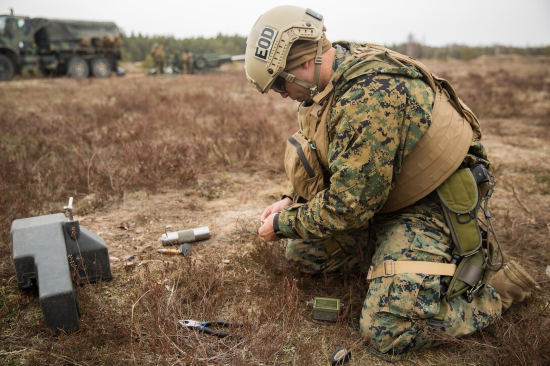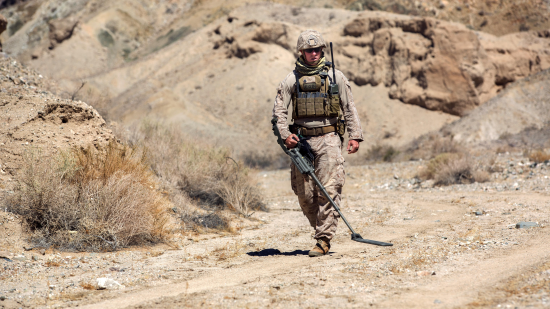A Marine Explosive Ordnance Disposal (EOD) Technician (MOS 2336) holds a high-stakes and specialized position within the U.S. Marine Corps.
EOD techs must meet specific qualifications and complete formal training at the Naval School for Explosive Ordnance Disposal.
This Military Occupational Specialty (MOS 2336) is not open to recruits or newly enlisted personnel below the rank of E-4.
Learn more about what it takes to become an EOD tech (MOS 2336) for the U.S. Marines.
Related Article – Navy Explosive Ordnance Disposal (EOD): Career Details
Table of Contents
Education, Qualifications, And Training

Enlisted Marines cannot join the EOD team right after basic training.
Marines must earn the rank of Corporal (E-4) before they can volunteer for this duty and become an EOD tech.
The EOD vetting process is stringent.
This is so that the most qualified and motivated Marines will make it through.
Marines who are interested in this MOS must submit themselves for screening, in person, by senior EOD personnel.
Therefore, the process is similar to a job interview in which excellence in all areas of education, qualifications, and training is expected.
Education
All Marines must complete high school with a diploma or GED equivalent.
In addition, they must have taken the Armed Services Vocational Aptitude Battery (ASVAB) upon enlistment.
The ASVAB is a series of tests designed to measure education and skill levels that helps to determine a Marine’s MOS.
To be considered for the EOD job, Marines must earn 110 or higher as a general technical score on the ASVAB.
However, if a Marine did not achieve this score during their initial ASVAB testing, there are opportunities to retake the exam.
Qualifications
There are basic qualifications to become an EOD technician.
You must be a U.S. citizen, and any dual citizenship has to be relinquished.
Marines must also qualify for or possess a Top-Secret security clearance.
In addition, EOD Marines must undergo a first-class fitness test and combat fitness test.
Normal color vision is a requirement.
Claustrophobia disqualifies EOD applicants.
A history of drug use other than “experimental use of cannabis” prior to enlistment also results in disqualification.
Training
As soon as a Marine is qualified and approved, they are transferred to an EOD unit.
There, they begin training on the job with expert supervision until their formal training starts at the EOD School in Florida at Eglin Air Force Base.
It is overseen by the Navy, with instructors and students from all U.S. military branches and Department of Defense civilians.
NAVSCOLEOD consists of academic training for 143 days, excluding weekends and holidays.
The program is divided into 10 separate training divisions:
- CORE
- Demolition
- Tools and methods
- Biological and chemical
- Ground ordnance
- Air ordnance
- Improvised explosive devices
- Nuclear ordnance
- WMD (Weapons of Mass Destruction)
EOD technicians are expected to continue their education once formal training is complete.
All 2336 Marines must be re-screened annually to ensure they are maintaining core competencies and continuing to refresh their training.
Related Article – Army EOD (MOS 89D): Career Details
What Does A Marine EOD Tech Do?

A Marine EOD technician performs various duties related to potentially harmful, hazardous, and/or explosive ordnance that presents a threat to operations, installations, personnel, and/or material.
Examples of such ordnance are:
- Chemical biological radiological nuclear and high-yield explosives (CBRNE)
- Unexploded explosive ordnance (UXO)
- Improvised explosive devices (IED)
- Weapons of mass destruction (WMD)
The duties an EOD tech is expected to perform in terms of these hazards are:
- Locating
- Accessing
- Identifying
- Rendering safe
- Neutralizing
- Disposing
EOD Marines are often deployed to foreign battlefields.
In addition, they may also coordinate with federal or local agencies under a domestic threat.
EOD technicians are prepared to face dangerous, intense conditions with an elevated risk of severe injury or even death.
As a result of such a high-stakes job, members of MOS 2336 can resign through an atypical Marine Corps order.
This order authorizes voluntary permanent removal from the MOS upon request for personal reasons.
This opportunity for resignation from an MOS is a rarity across the branches of the U.S. military.
How Much Does A Marine EOD Tech Make?
A Marine EOD technician (MOS 2336) must hold the rank of E-4 or higher.
At this rank of Corporal, the monthly salary is approximately $2,500.
Marines receive pay according to their rank and years of service.
However, Explosive Ordnance Disposal personnel are often authorized for additional Hazardous Duty Pay.
This can increase a Marine EOD tech’s net pay by $150 to $250 per month, depending on rank.
According to average salary reports, a typical EOD tech in the Marines earns around $57,000 per year.
In addition to salary, the Marine Corps offers benefits to its members such as:
- Medical insurance coverage
- Leave (paid time off)
- Retirement
- Housing allowance
- Cost of living allowance
- Dining and shopping privileges on base
- Tuition (G.I. Bill, scholarships, additional stipends for education purposes and expenses)
Additionally, members of the U.S. military branches often receive discounts and privileges in the civilian sector as well.
Job Reviews
Most Marines who serve under MOS 2336 report that they are proud to earn this position.
Many claim that they feel the work is valuable, rewarding, and constantly evolving.
However, many job reviews reflect the hardships and stress of being a Marine EOD tech.
Some of the concerns include multiple deployments, strain and time away from home due to work hours, and demanding job expectations.
Civilian Career Opportunities
EOD Marines can apply their training and experience toward a journeyman apprenticeship through the United Services Military Apprenticeship Program (USMAP).
Therefore, this allows Marines with EOD specialty skills to work towards receiving a nationally accredited journeyman certification as an ordnance artificer.
In addition, the overall experience, skills, discipline, leadership, and service that you gain as a Marine is highly sought after and regarded in many civilian careers.
Former Marines often transition to the civilian sector as contract employees in relation to their occupational specialty.
Other government agencies, including law enforcement and security, provide excellent civilian career opportunities.
Related Article – 10 Best Marine Corps Jobs For Civilian Life
Conclusion
An EOD badge on a Marine uniform signifies the intense training and commitment of a service person who qualified for and earned the MOS 2336.
Marine EOD technicians are essential during combat and wartime on foreign soil and even in times of peace if a domestic threat is present.
Therefore, these service members place themselves in high-risk and intensely stressful situations.
Their expertise in handling and undertaking responsibility for hazardous ordnance serves to protect civilians as well as military personnel and material.
References
- Replacing Dog Tags: 6 Things You Need to Know - June 28, 2024
- Navy OAR Test Study Guide - June 24, 2024
- 10 Best Sniper Movies of all Time - June 20, 2024
Originally posted on February 2, 2022 @ 8:56 am
Affiliate Disclosure: This post may contain affiliate links. If you click and purchase, I may receive a small commission at no extra cost to you. I only recommend products I have personally vetted. Learn more.

